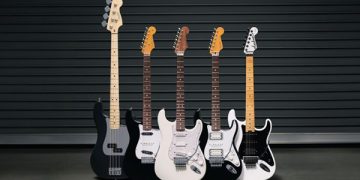 As with a handful of other fiefdoms within the world of MI, the pandemic has actually been good for sales of pro audio equipment – in particular entry- and mid-level gear that can facilitate home recording and the like. As time progresses, however, certain challenges such as supply-chain interruptions threaten to throw some cold water on the party.
As with a handful of other fiefdoms within the world of MI, the pandemic has actually been good for sales of pro audio equipment – in particular entry- and mid-level gear that can facilitate home recording and the like. As time progresses, however, certain challenges such as supply-chain interruptions threaten to throw some cold water on the party.
MMR recently spoke with reps from five industry-leading suppliers of audio interfaces to learn about trends in this market segment during the early days of lockdown through to the present. Their feedback shines a light on how this type of gear is truly connecting with end-users and helping to realize the creative impulses of many at a time when such an outlet and release is desperately needed.
In the past 18 or so months, there’s been a huge spike in home and remote music creation and recording, podcasting, et cetera. How have sales for your brand been impacted by the pandemic and periodic lockdowns?
Paul Youngblood: TASCAM was positioned nicely for this. The TASCAM brand is legendary, and the TASCAM strategy has always been about home recording, music creation, and value, bringing the most features and technology together at an affordable, realistic price. Because of this, we saw an increase in sales and demand much beyond our expectation.
Ryan Roullard: As folks looked to new hobbies and outlets to occupy their time stuck at home, many decided to try out music creation and livestreaming. Audio interfaces, microphones, Studio One, and PreSonus Sphere have performed phenomenally for us during what has otherwise been a trying time. On the other hand, live sound products like sound reinforcement loudspeakers have struggled right alongside the live music venues that rely on them. In a world where gathering isn’t very safe, demand for live sound equipment was understandably hamstrung.
Stefan Schreiber: For the year 2020 we observed a significant sales increase, especially for entry-level products like two-channel audio interfaces and podcasting equipment. Since the beginning of 2021, sales have returned to the level that it was prior to the pandemic. Generally speaking, gear designed for personal home recording and that which enables collaborations in music production have experienced a significant increase.
Dan Boatman: Like many companies, sales of our recording and music creation accessories increased dramatically during the lockdown. The lift was most dramatic in interfaces, microphones, and software, as I think a lot of musicians took the opportunity (and probably their stimulus) to upgrade their setup. We saw a lot of interest in more premium products, like our AXE I/O audio interface, our iLoud MTM studio monitors, and our Total Studio 3 Max software bundle – all products that are a step-up from the more low cost, entry level items.
Jimmy R. Landry: There is no doubt it has been an interesting time for M-Audio and MI in general. Thankfully, we have seen sales spikes, but that is just part of the conversation. A greater conversation is navigating supply and demand during times like this. Variables such as the availability of parts, new marketing tactics, and even logistics are all part of the sales landscape these days.
What are the hottest models of audio interfaces for your brand?
RR: Since there’s a ton of new customers getting into music and media creation for the first time, the hottest sellers continue to be smaller, entry-level interfaces like the Studio 24c and 26c, and of course the Revelator, where customers essentially get a microphone, interface, signal processor, application mixer, and DAW in a single purchase.
More seasoned producers are looking to the ioStation 24c, as it’s a 2-channel interface and DAW controller in a single, small-footprint device. And the AudioBox Studio Bundles have done really well because they include everything you need to record, including cables and a comprehensive software suite making them an affordable solution for customers looking for an all-in-one package.
DB: Where we saw the biggest growth by far was on our streaming interfaces like iRig Stream, which was really the first custom-built audio interface for mobile streaming. Musicians suddenly needed a way to connect to Instagram, Facebook, Tiktok, Clubhouse – all these different apps became the only way for musicians to connect with fans, and since our iRig Stream was built just for that, the demand was absolutely incredible. We had DJs comparing the demand for these products to when there was that run on toilet paper and other essentials – they needed them that badly.
JL: We have recently seen a lot of success with our M-Track Duo, M-Track Solo and AIR 192×4 interfaces – and the whole AIR line, really. It is an interesting scenario because the two lines serve a different type of customer which shows a wide net of musicians, podcasters, and creators of all different levels learning how to take their productions into their own hands – something that M-Audio has always stood for.
SS: Currently, our hottest audio interfaces must be our line-up of UR-C audio interfaces – especially the UR22C and the UR22C Recording Pack have been well received. What is special about our UR-C interfaces is that they are affordable yet offer so many great features, such as on-board DSP effects and an easy-to-set-up loopback mode for streaming – offering premium sound quality when streaming performances through social media channels. We have witnessed influencers hosting living room concerts from home during the pandemic to maintain the connection to their network. The UR-Cs are perfect for these kinds of occasions. Also, as a direct consequence to the situation that many people are currently working from home, we decided to release a firmware update with a new voice chat mode that is optimized for video conferencing.
PY: Actually our hottest audio interface is the Model 12, which is a combination mixer, multi-track recorder, audio interface and control surface. The value and technology are astounding.
Even after several years, the US-16×08 has become a standard with its sheer amount of I/O and capability at an affordable price point.
The new US-HR (High Resolution) lineup is hot because of their super high specifications, our new drivers, and we added truly usable software bundles. The software bundles are not based on quantity, but musical quality. We did not want the customer to be constantly pitched on a software program that is shown but really not available with annoying pop ups asking for a purchase. For example, the US-HR lineup come with a full studio version of IK Multimedia Sample Tank, CubaseLE, Cubasis, and a free three-month subscription to the complete Auto-Tune collection. Even the ultra-affordable US-1x2HR has all this.
What are some “best practices” adopted by dealers who are especially successful in servicing this market segment?
SS: I believe dealers who realized early on that customer demands changed during the pandemic did the best job and were especially successful over the past year. Helping customers make the right choices to easily continue to make music at home, to be creative and collaborate remotely made all the difference during these challenging times.
JL: This is the great question of the times. We have all been through unprecedented situations in the last 18 months and I think there has been a lot to learn. The best “best practices” have certainly shifted and been tested. Obviously, many retailers and even manufacturers had to quickly pivot and figure out their online components from their presence to their backend systems, and even digital marketing. Furthermore, many conversations took place on how to even talk to customers during such an incredibly difficult time. We have so many great dealers in our M-Audio network that showed their true colors by recognizing and connecting with musicians having a hard time. From grounded touring musicians to others working from home, and to even those in more unfortunate situations, we heard a lot of positive stories from dealers and manufactures that made us proud to be part of this industry – the pivot to online sales was at the forefront, but I think humanity became a “best practice” for most in our industry.
PY: In this market segment, the dealers who invest in knowledgeable staff who know recording technology and the latest information are always going to win. It’s hard to fake knowledge of high-tech recording today. Does your website or staff discuss the value of drivers and latency? Does your website or staff translate the benefit of high specifications and software bundles into language a creative musician understands? The #1 TASCAM dealer in dollars is not #1 for TASCAM audio interfaces. Our #1 audio interface dealer tends to focus on recording and application and it shows.
DB: I think education is really key. For a moment there, really almost the entire music world had to stop and learn how to share or stream online, so the dealers who took that moment to inform users which products fit which needs really benefitted the most. Or those who had already established themselves as that “trusted source!” As much content as we brands put out, I think users still really rely on neutral third parties who can represent the full range of options. So the dealers who made the investment in social media, YouTube, articles, et cetera all saw a big benefit as they met that tidal wave of customer demand.
RR: Have a salesperson or two who understands the value proposition of these products and is equally knowledgeable in podcasting and livestreaming – particularly in setup and routing. You’ve probably got a guitar instructor on staff, and maybe a vocal coach; why don’t you have an online content expert?
I can’t stress enough that most of your customers for these products are going to be entry-level. So don’t come at them from a “pro audio” perspective. This crowd typically doesn’t know what a sampling rate is, so make every effort to demystify the technology and make it as non-intimidating as possible.
Do you have any new or upcoming audio Interface models that you’d like to draw MMR readers’ attention to?
DB: Yes. Given the success and market leadership of our iRig Stream, we have some exciting expansions to that family that take all the lessons we learned last year. We spent the pandemic working with everyone from home DJs to world-class artists, and meeting with many of the most popular streaming apps, and we’re excited to leverage that knowledge into some really innovative new stuff coming later this month and beyond!
RR: You bet! The Revelator io24 is our latest two-channel interface. It essentially allows users to turn whatever mics they already have into Revelators, taking advantage of all the signal processing, loopback routing, and presets that Revelator is known for. It’s an amazing tool for podcasters and streamers, but being PreSonus, we didn’t forget about musicians: It has MIDI I/O and ships with our Studio One Artist DAW.
I can’t talk about future plans other than to say you’re probably going to be pleasantly surprised.
JL: The AIR 192|8 is really an incredible value for those who have a home project studio. It’s super versatile unit for seasoned music creators, or for those who are just starting a home product studio and want professional results. Like the whole AIR line, it features the transparent Crystal Preamps, but just as importantly has great A/D D/A converters which is something many overlook. You always hear people talking about preamps, but if you don’t have great quality converters to go along with those preamps, the end result of your project may not sound as big as it could. Our world-class Product Team did a great job on the AIR line which delivers high-level quality on all fronts.
PY: Sometimes it’s about other items in addition to the hardware. For example, the new US-HR lineup and the entire TASCAM line have new drivers. Drivers and OS compatibility are so important. Our new drivers can go down to 4 samples depending on the computer CPU which translates to high performance and very low latency. TASCAM audio interfaces have very low latency, and that translates to a great feel and musicality.
I mentioned the Model 12 and it breaks all the rules. Instead of the usual table top box with a big knob, a couple of buttons, and moderate I/O, we integrated several TASCAM technologies into the model 12. It’s got the tactile interface of an old-school analog mixer complete with several channel strips, long throw faders, lots of I/O, and big track arm buttons. But inside it’s a super high-tech recording interface, control surface, and multi-track recorder.
SS: We will continue to focus on our popular range of UR-C interfaces by providing firmware updates and continue to introduce new features – I suggest looking out for these new feature additions. Also worth mentioning are the exciting use-case-specific hardware/software bundles that we’ve already planned.
Expectations for this market segment in the coming months?
JL: We are thinking hard about the short-, mid-, and long-term plans in general like every manufacturer these days. With more people working from home and the economy picking back up, we think sales will continue to be strong for M-Audio and our market segment thankfully. Once things get back-to-normal a bit more in terms of travel and safety, we think there will be a rebound and surge of live performances resulting in a wave of live and mobile gear sales.
SS: Podcasting and vlogging are the most popular kids on the market block, and we’re happy to be able to provide the necessary tools to maintain their popularity. We also notice an increase in the demand for more sustainable products. As a result, customers are content to stick with their audio interfaces. In light of these demands and to take responsibility, we plan to continue providing regular updates for our range of hardware products.
PY: The big demand for home recording that we saw in 2020 through early 2021 is dropping. But it’s still substantially higher than before 2020. We see the next big opportunity as dedicated podcasting and streaming products, which are simply variations of audio interfaces and recorders.
DB: I think there was a dip as musicians were finally able to get out and start gigging again, since there was so much pent-up demand for that. But as the weather turns we’re confident musicians won’t abandon the social fanbases they built online, so we’re expecting an extremely strong holiday season. I think this new streaming market is here to stay, and it’s something dealers need to make a regular part of their assortment.
RR: Only growth. Daily work-from-home and the normalization of online videoconferencing has raised the expectations of quality in a typical user’s online presence. And it turns out that there are a lot of people on the Internet.



























Looking Back on 2025: A Year of Controlled Chaos (Emphasis on “Controlled”)